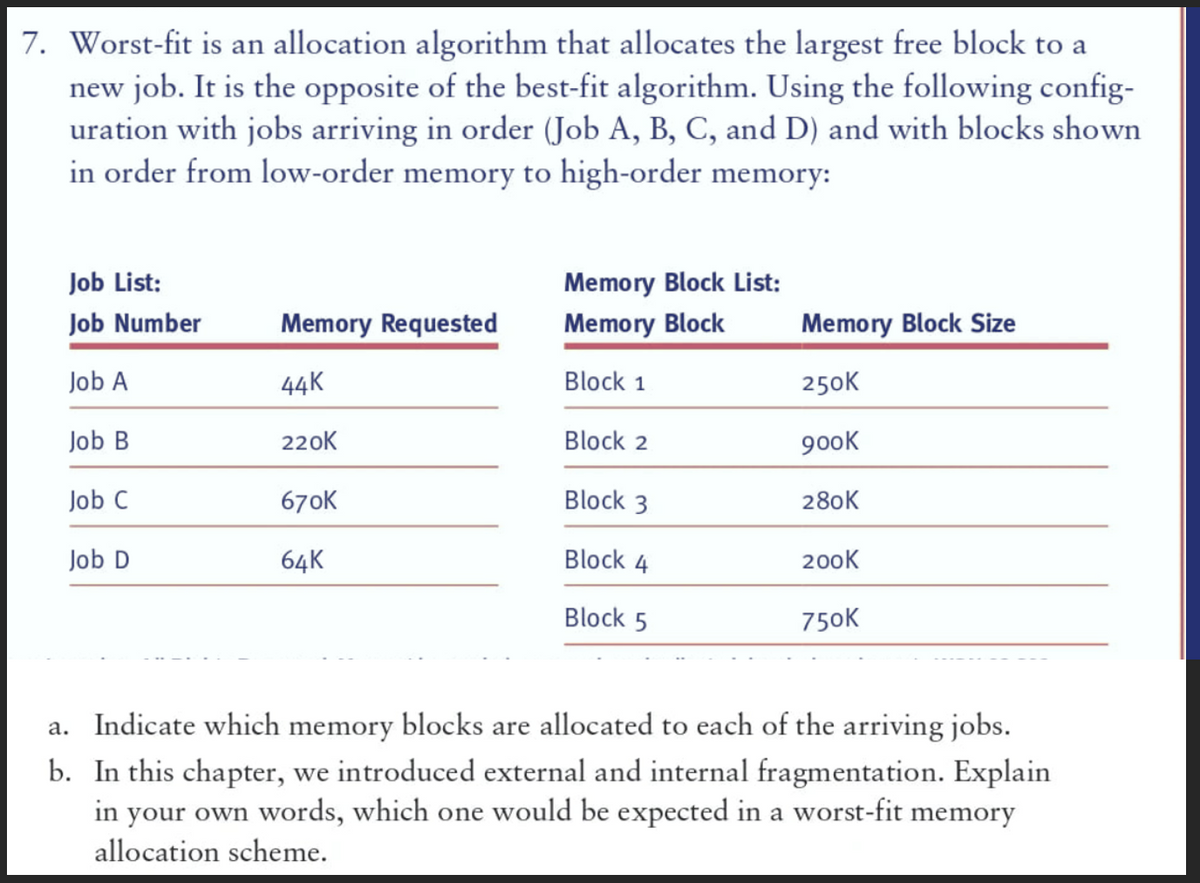7. Worst-fit is an allocation algorithm that allocates the largest free block to a new job. It is the opposite of the best-fit algorithm. Using the following config- uration with jobs arriving in order (Job A, B, C, and D) and with blocks shown in order from low-order memory to high-order memory: Job List: Job Number Job A Job B Job C Job D Memory Requested 44K 220K 670K 64K Memory Block List: Memory Block Block 1 Block 2 Block 3 Block 4 Block 5 Memory Block Size 250K 900K 280K 200K 750K a. Indicate which memory blocks are allocated to each of the arriving jobs. b. In this chapter, we introduced external and internal fragmentation. Explain in your own words, which one would be expected in a worst-fit memory allocation scheme
7. Worst-fit is an allocation algorithm that allocates the largest free block to a new job. It is the opposite of the best-fit algorithm. Using the following config- uration with jobs arriving in order (Job A, B, C, and D) and with blocks shown in order from low-order memory to high-order memory: Job List: Job Number Job A Job B Job C Job D Memory Requested 44K 220K 670K 64K Memory Block List: Memory Block Block 1 Block 2 Block 3 Block 4 Block 5 Memory Block Size 250K 900K 280K 200K 750K a. Indicate which memory blocks are allocated to each of the arriving jobs. b. In this chapter, we introduced external and internal fragmentation. Explain in your own words, which one would be expected in a worst-fit memory allocation scheme
Computer Networking: A Top-Down Approach (7th Edition)
7th Edition
ISBN:9780133594140
Author:James Kurose, Keith Ross
Publisher:James Kurose, Keith Ross
Chapter1: Computer Networks And The Internet
Section: Chapter Questions
Problem R1RQ: What is the difference between a host and an end system? List several different types of end...
Related questions
Question

Transcribed Image Text:7. Worst-fit is an allocation algorithm that allocates the largest free block to a
new job. It is the opposite of the best-fit algorithm. Using the following config-
uration with jobs arriving in order (Job A, B, C, and D) and with blocks shown
in order from low-order memory to high-order memory:
Job List:
Job Number
Job A
Job B
Job C
Job D
Memory Requested
44K
220K
670K
64K
Memory Block List:
Memory Block
Block 1
Block 2
Block 3
Block 4
Block 5
Memory Block Size
250K
900K
280K
200K
750K
a. Indicate which memory blocks are allocated to each of the arriving jobs.
b. In this chapter, we introduced external and internal fragmentation. Explain
in your own words, which one would be expected in a worst-fit memory
allocation scheme.
Expert Solution
This question has been solved!
Explore an expertly crafted, step-by-step solution for a thorough understanding of key concepts.
This is a popular solution!
Trending now
This is a popular solution!
Step by step
Solved in 3 steps

Recommended textbooks for you

Computer Networking: A Top-Down Approach (7th Edi…
Computer Engineering
ISBN:
9780133594140
Author:
James Kurose, Keith Ross
Publisher:
PEARSON

Computer Organization and Design MIPS Edition, Fi…
Computer Engineering
ISBN:
9780124077263
Author:
David A. Patterson, John L. Hennessy
Publisher:
Elsevier Science

Network+ Guide to Networks (MindTap Course List)
Computer Engineering
ISBN:
9781337569330
Author:
Jill West, Tamara Dean, Jean Andrews
Publisher:
Cengage Learning

Computer Networking: A Top-Down Approach (7th Edi…
Computer Engineering
ISBN:
9780133594140
Author:
James Kurose, Keith Ross
Publisher:
PEARSON

Computer Organization and Design MIPS Edition, Fi…
Computer Engineering
ISBN:
9780124077263
Author:
David A. Patterson, John L. Hennessy
Publisher:
Elsevier Science

Network+ Guide to Networks (MindTap Course List)
Computer Engineering
ISBN:
9781337569330
Author:
Jill West, Tamara Dean, Jean Andrews
Publisher:
Cengage Learning

Concepts of Database Management
Computer Engineering
ISBN:
9781337093422
Author:
Joy L. Starks, Philip J. Pratt, Mary Z. Last
Publisher:
Cengage Learning

Prelude to Programming
Computer Engineering
ISBN:
9780133750423
Author:
VENIT, Stewart
Publisher:
Pearson Education

Sc Business Data Communications and Networking, T…
Computer Engineering
ISBN:
9781119368830
Author:
FITZGERALD
Publisher:
WILEY